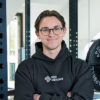
Lateral ligament ankle injuries are extremely common, especially in sports where they account for 40% of all musculoskeletal injuries. Around 40-50% of these cases leave athletes with long-term symptoms, and sometimes chronic ankle stability issues.
The lateral ankle ligament complex is made up of three main ligaments, comprising the anterior fibular ligament (ATFL) posterior fibular ligament (PTFL) and the calcaneofibular ligament (CFL).
The ATFL is the most vulnerable of the three ligaments ,with 66% of all lateral ankle sprains being solely attributed to the ATFL. When the ankle goes into a varus movement (rolling the ankle away from the body) the ATFL is easily sprained or torn as it located the most anteriorly of the three.
CFL, the second most vulnerable ligament to injury, makes up around 20% of lateral ankle sprains, it is located slightly posteriorly to the ATFL. And finally the PTFL, which is the most posterior ligament, is the least likely of the ligaments to be sprained, and accounts for the remaining 14%.

Common Causes & Symptoms
Common scenarios for ankle sprains to occur are walking on uneven surfaces, exercising heavily or simply walking downstairs – they can cause a misposition of the foot during the landing phase, coupled with a delayed response from the calf muscles. As the tension on the ligament(s) increases the strain becomes too much, leading to a sprain or tear. Bigger impacts such as lancing from a jump or decelerating from high speed will cause more severe sprains or tears due to increased tension exerted on the ligament(s).
With any ligament sprain there are a few telltale signs, these usually include bruising, swelling, localised pain and movement dysfunction. With lateral ankle sprains there’s a 20-40% chance that the ATFL and CFL are both sprained.
Treatment & Rehabilitation
An acronym you can remember for the acute phase (5-14 days after injury) of an ankle sprain is PEACE – Protect, Elevate, Avoid Anti-Inflammatory Modalities, Compress and Educate. After the acute phase we can move onto another acronym , LOVE – Load, Optimism, Vascularisation and Exercise. Combining this with a well constructed rehabilitation programme which includes strengthening exercises, increasing range of motion and proprioception exercises.
By strengthening the muscles around the ankle (the tibialis anterior, peroneals and gastrocnemius) you can promote recovery and create greater stability within the ankle. Proprioception exercises include sensory balance training, coordination and stability exercises, such as mobilising and plyometrics.
Finally, for those involved in sports you can progress to putting stress back through the ligaments with agility drills, change of direction and replication of movements in your chosen sports. This is called the return to field phase of injury rehabilitation.

